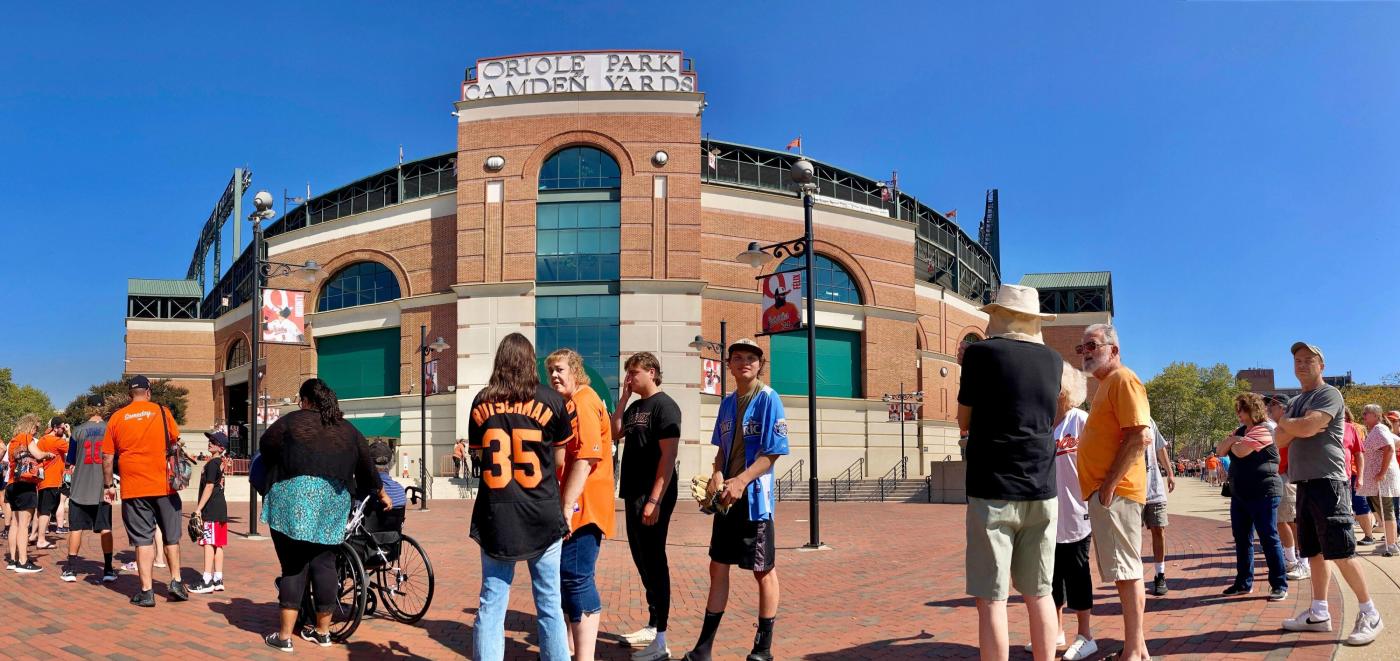
‘Essentially gifting the land’: Economists pan land deal with Orioles; state says it will ‘reinvigorate’ Camden Yards
In its memorandum of understanding with the Orioles, the state of Maryland has set itself up to receive less revenue from state-owned land near Camden Yards — handing potentially lucrative profits to the team.
Revenue that could reach millions of dollars annually from the development of land and real estate, including the Camden Yards warehouse, would flow to the ballclub. It would come on top of at least $600 million in public money for Oriole Park improvements already approved by the General Assembly, and would be in addition to a further state fund proposed in the memorandum.
“That’s a lot of money,” Kennesaw State University economist J.C. Bradbury said, “and it’s unlikely to pay off to the public.”
In the memorandum announced Sept. 28, the state agreed to lease to the Orioles land near the ballpark for 99 years for annual rent totaling $94 million. But the sticker price is less valuable than it might appear when factors like inflation over nearly a century are considered.
Viewed in present-day dollars, the Orioles will pay the state an average of $129,000 to $208,000 per year for the rights to develop and potentially profit from land surrounding the stadium, according to an analysis from Geoffrey Propheter, a University of Colorado Denver professor who wrote a 2022 book titled “Major League Sports and the Property Tax.”
When compared with alternatives, such as the state itself continuing to rent the warehouse to tenants or selling the land to a developer and returning it to state and city tax rolls, the ground lease yields “a trivial amount of revenue,” Propheter said.
“It’s a pitiful amount of money,” said Dennis Coates, an economist at the University of Maryland, Baltimore County.
The former B&O Railroad warehouse at Camden Yards is the jewel of the ground lease and it, like Oriole Park and M&T Bank Stadium, is owned and rented out by the Maryland Stadium Authority. The warehouse, whose tenants include law, advertising and medical offices, netted $638,000 in profit during the most recent fiscal year, the authority said.
With redevelopment, it could be much more lucrative.
The stadium authority retained Crossroads Consulting and Entreken Associates Inc. in 2019 to provide economic advisory services regarding the historic, 430,000-square-foot building. The consultants’ report, obtained by The Baltimore Sun, said that if the warehouse is converted to a hybrid of retail, hotel, apartment, and/or office space — at a cost ranging between $16 million and $36 million — it could produce net operating income of $4.6 million to $7.1 million annually.
Under the new memorandum, which is nonbinding but which the two parties say is the precursor to a lease, the Orioles, not the state, would be in charge of paying for development and receive potential profits.
“This is essentially gifting the land to the Orioles,” said Bradbury, who often critiques stadium subsidies.
The flip side for the state is that — as part of the still-to-be-reached lease agreement — the Orioles would commit to staying in Baltimore for 30 more years. Plus, the land around Camden Yards, currently largely dormant, would be more effectively used. The stadium authority and Orioles both envision a year-round, entertainment destination with varied attractions that would boost Baltimore’s downtown.
The land has been underutilized for years. Camden Station, which previously hosted the Sports Legends Museum and Geppi’s Entertainment Museum, has not had tenants since 2018. Only about half of the square feet in the neighboring warehouse is used, mostly as office space. That “limits activity to weekday working hours,” the stadium authority said in a statement.
“Private investment coming to the warehouse as well as the vacant Camden Station building and surrounding area will help reinvigorate and re-imagine the space, drawing visitors not just on game days but year-round,” spokesperson Rachelina Bonacci wrote.
Democratic Gov. Wes Moore has championed the memorandum of understanding, saying it will shape “the economic future of the city.”
David Turner, a senior adviser and communications director for Moore, cited the economic impact of entertainment districts around the MLB homes of the Atlanta Braves, St. Louis Cardinals, Colorado Rockies and Texas Rangers.
In a statement Thursday, he described the memorandum as a “paradigm shift for the Camden Yards complex” and said the area’s development would result in more foot traffic to the area and tax revenue for the state.
“The new Camden Yards will bring visitors from across and outside the city to spend time downtown, whether there is a game happening or not,” Turner said.
Many economists, however, have argued that subsidizing stadium districts does not benefit the average citizen.
A spokesperson for Orioles CEO and Chairman John Angelos declined to comment, but Angelos has said he hopes to create a “live, work, play” district.
Earlier this year, he and Moore visited the Braves’ suburban stadium and its entertainment district, The Battery, which was developed by commercial real estate company JLL into residential, retail and office spaces, as well as bars and restaurants. In a January letter to Moore, Angelos noted that the Orioles had engaged JLL “to assist in maximizing our creative vision for Oriole Park.”
The Baltimore club would continue a trend of pro teams developing the areas around their stadiums. Asked why it is increasingly common for sports teams to involve themselves in land development, Propheter said: “Why does any business do anything? It’s because they expect a profit.”
The ground lease is one part of the eight-page memorandum of understanding signed by Angelos and stadium authority Chair Craig Thompson.
Jesse Saginor, a professor at University of Maryland’s Real Estate Development Program, said leasing land to pro teams for a low rate is not atypical.
“That discount there is basically a sweetener, ideally so that the team will want to stay,” he said.
The club’s lease for Oriole Park — which binds it to the city and to the state-owned stadium — expires Dec. 31.
Angelos has promised to keep the team in Baltimore and the state committed in April 2022 at least $600 million in improvements to the ballpark to strengthen the prospects of signing the Orioles to a long-term lease. The recent memorandum states that the Orioles would remain in the city for 30 more years.
But fans’ fears about a sale of the Orioles leading to a move were stoked last year when an internecine dispute over the assets of his ailing father spilled into public, revealing acrimonious statements about possible preparations to put the team on the market after Peter Angelos dies.
The memorandum of understanding further details additional financial agreements. The Orioles will pay for operation and maintenance of the ballpark, but will stop paying annual rent. That will ultimately save the state millions of dollars a year and is similar to the arrangement it has with the Ravens for M&T Bank Stadium.
However, the Orioles, in addition to the ground lease, would receive $3.3 million annually for a repair fund that would total $100 million over 30 years. Those are benefits the Ravens do not receive. Because of parity clauses in the teams’ leases, the state might have to provide the equivalent to the NFL team.
The fund would require General Assembly approval and it’s unknown if the legislature would pass such a bill. The legislature isn’t scheduled to meet again until January, but that does not necessarily mean the lease could not be signed before then.
“It is common for contracts to be signed that include terms covering future events, conditions, or approvals,” said Turner, Moore’s communications director.
The memorandum has also been criticized by former stadium authority leaders for giving construction and operating power over the ballpark to the Orioles.
Asked if the Orioles would have the authority to determine how public money is spent, Bonacci, the authority’s spokesperson, said in a statement: “the team is expected to have a larger role in contractor selection and project administration, following models from other stadiums and subject to significant Maryland Stadium Authority controls and approvals.”
Christopher Ryon, a Baltimore-based procurement attorney, noted that the stadium authority has procurement experience, unlike the Orioles, and wondered what procurement guidelines the club would need to follow.
“Those are important details that still need to be worked out between the parties,” Ryon said.
Economists who study stadium subsidies have long warned that publicly funding venues for privately owned sports teams is bad business for taxpayers. Coates, the UMBC professor, criticized the decision-making of the General Assembly and then-Gov. Larry Hogan for approving at least $1.2 billion for the Orioles’ and Ravens’ stadiums in 2022.
On Wednesday, he further decried the recent memorandum for awarding the Orioles additional resources in the form of state land and funds.
“I’d like to see some discussion of what can be done with that money,” he said, “besides it being given to a sports team for their own profit.”
()


